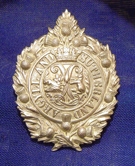Argyll and Sutherland Highlanders Glengarry Badge 1882 to 1900 Pattern
In pressed nickel with good clear definition and in good condition, 2 lugs. read more
45.00 GBP
US Army WW2 Garrison Cap, Khaki, Officer's Tropical Issue
With Quarter Master label, dated June 1945. Pattern date 1942. Good condition. read more
30.00 GBP
French 1830'S Shako Helmet Plate
Brass plate of Cockerel and stamp of 'Return to Liberty' July 1830 read more
90.00 GBP
French 1830's Shako Helmet Plate.
Copper plate of a Cockerel over French symbols. read more
90.00 GBP





